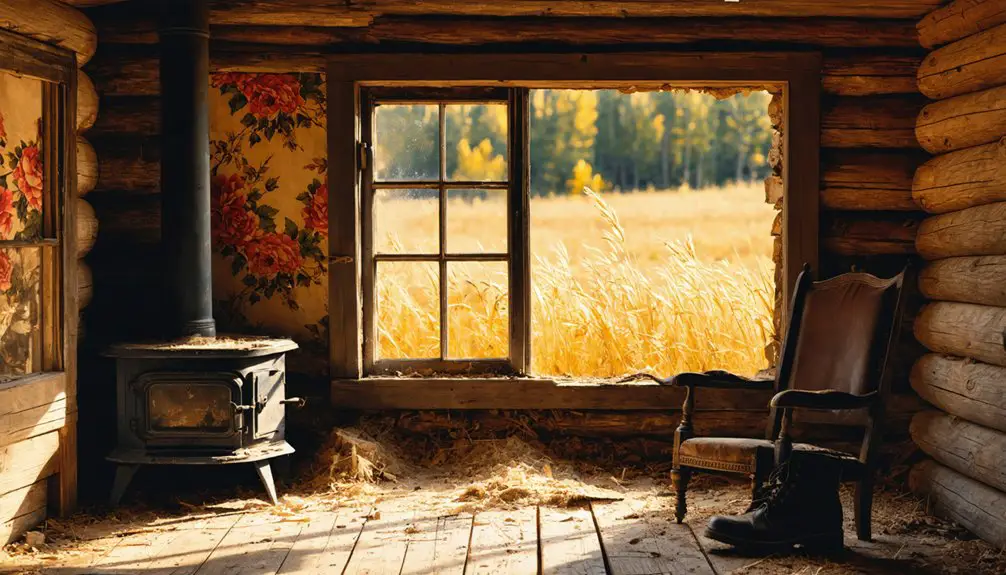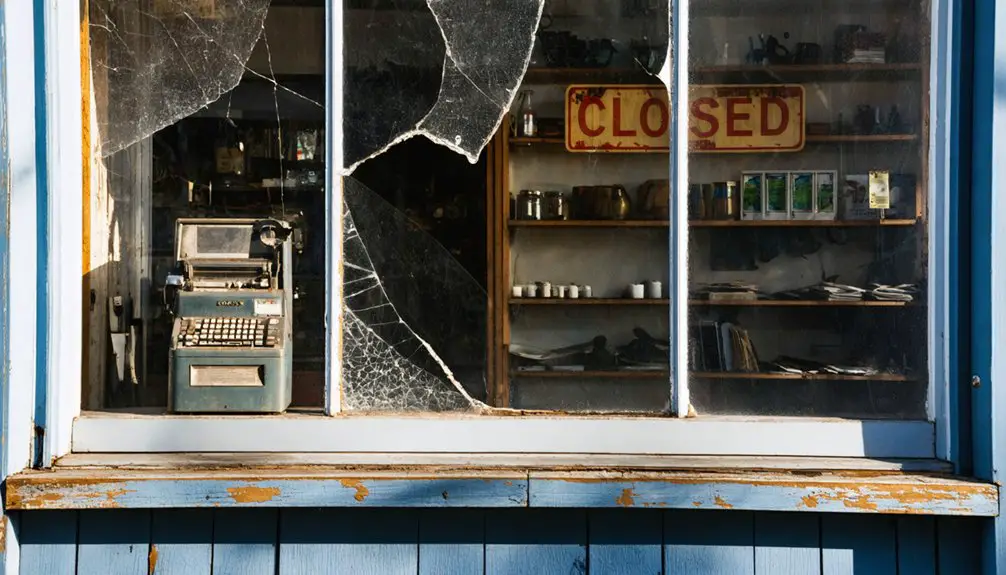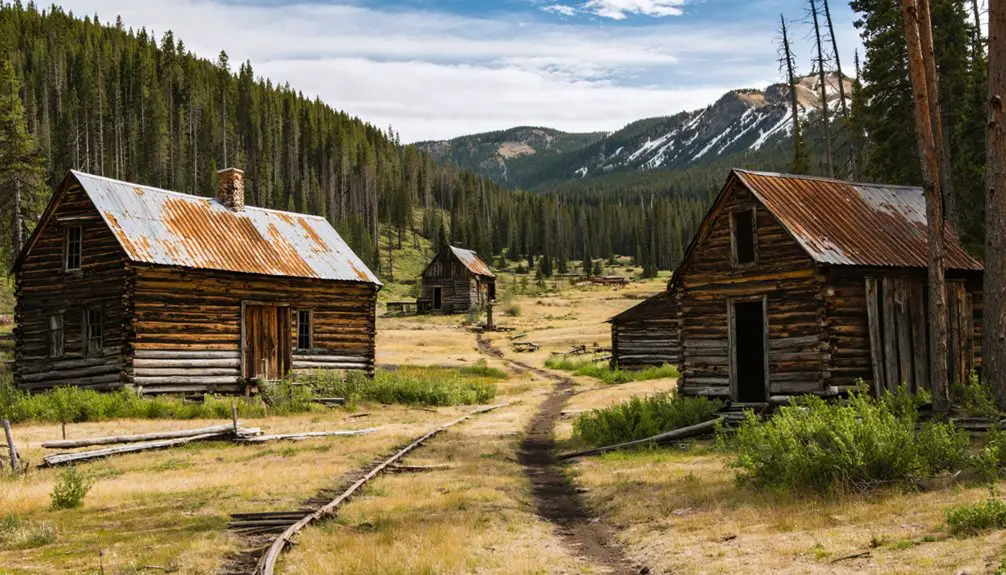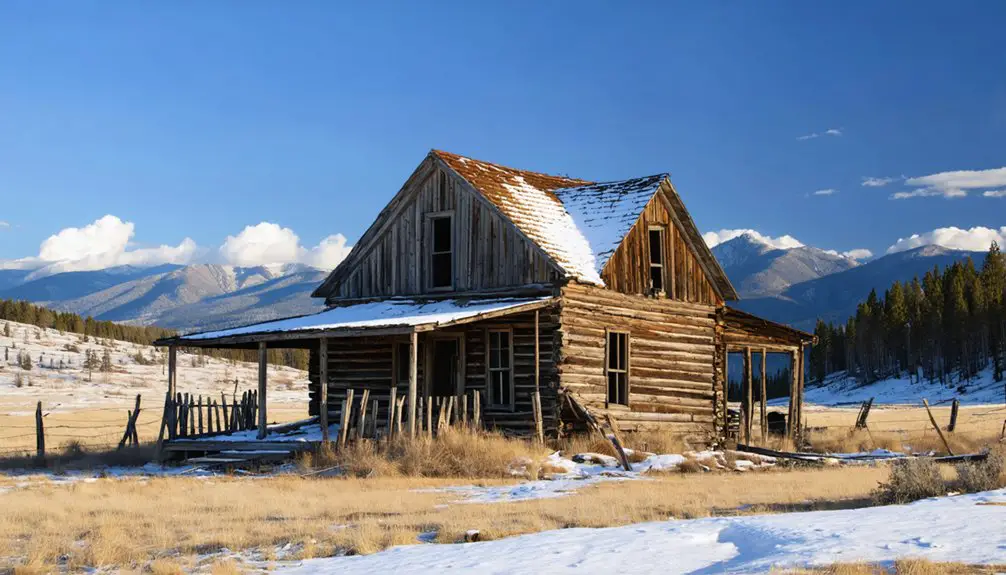You’ll find Lion City nestled in Montana’s Pioneer Mountains, where it flourished as a silver mining boomtown from 1872 to 1893. Founded by William “Billy” Spurr and James Bryant after their Trapper Lode discovery, the town supported up to 2,000 residents with its sophisticated mining infrastructure, including a 40-ton smelter and cable car system. Though the Sherman Act’s repeal triggered its decline, Lion City’s preserved ruins and scattered mining artifacts tell a fascinating story of Montana’s mineral wealth.
Key Takeaways
- Lion City was established in 1877 as a silver mining settlement in Montana’s Hecla Mining District with advanced mining infrastructure.
- The town’s mining operations produced over 13.3 million ounces of silver and 18,250 ounces of gold between 1873-1965.
- At its peak, Lion City supported up to 2,000 residents with facilities including saloons, hotels, a church, and a school.
- The town featured sophisticated mining technology including a 40-ton smelter, cable car system, and extensive underground tunnel networks.
- Today, approximately 15 structures remain, including remnants of commercial buildings and mining facilities, accessible via 4WD roads.
The Rise of a Silver Mining Boomtown
While silver mining transformed many parts of Montana in the late 1800s, Lion City‘s story began in 1872 when William “Billy” Spurr and James Bryant staked the first claim in what would become the Hecla Mining District.
After discovering the Trapper Lode’s silver claims, miners quickly established Trapper City, complete with a post office, hotel, and saloons. You’ll find that by 1873, nearly 200 people called these early camps home. The thriving district eventually reached peak populations of around 2,000 residents.
As miners faced the mining challenges of accessing deeper deposits, they pushed operations up Lion Mountain. By 1877, they’d established Lion City as their new base, building infrastructure that included a 20-stamp mill during the Penobscot Mining Company era.
The settlement proved remarkably productive, contributing to a district-wide yield of over 13 million ounces of silver and substantial amounts of other valuable metals. Lion City grew rapidly into a thriving community with a population of 600 by 1878.
Life in Montana’s Pioneer Mountains
Stretching across southwestern Montana near the Idaho border, the Pioneer Mountains offered both opportunities and challenges for settlers drawn to the region’s rich mineral deposits.
You’d find yourself maneuvering a pioneer lifestyle amid towering peaks, where old-growth forests of lodgepole and whitebark pine create a rich mountain ecology teeming with elk, moose, and black bears.
The rugged terrain and seasonal weather patterns would’ve tested your resilience, demanding adaptation to high-altitude living and limited agricultural options. The eastern section features alpine basins and lakes that provided vital water sources for early settlers.
Life centered around resource-based activities – mining silver, hunting game, and logging the dense forests. Native peoples including the Shoshone and Bannock tribes had long established seasonal hunting grounds in these mountains before settlers arrived.
From silver in the mountains to game in the forests, pioneers built their existence around the natural bounty of the land.
While the Pioneer Mountain Scenic Byway now provides easy access, you’d have faced significant logistical challenges in those early days, relying on tight-knit communities and local knowledge to survive in this demanding environment.
Mining Operations and Economic Impact
You’ll find Lion City’s mining operations were powered by sophisticated infrastructure, including a 40-ton smelter, three 50-ton blast furnaces, and an overhead cable car system that transported rich silver-lead ore across four miles to the stamp mill.
The district’s remarkable production from 1873 to 1965 yielded over 18,250 ounces of gold, 13.3 million ounces of silver, and millions of pounds of copper, lead, and zinc valued at $19.65 million. The Montana Brewery operated during this period, making Glendale one of the most civilized mining towns in the region. The Longmaid Brothers constructed a 20-stamp concentrator in the area during 1907-1908.
While the boom created a thriving economy supporting up to 2,000 residents in Glendale alone, the 1893 repeal of the Sherman Silver Purchase Act triggered the district’s eventual decline, leading to the dismantling of the smelter by 1900 and sporadic operations until 1922.
Rich Silver-Lead Ore Production
As one of Montana’s most productive mining regions, the Hecla/Bryant district generated an impressive 656,078 tons of ore between 1873 and 1965, yielding over 13.3 million ounces of silver and 112.4 million pounds of lead. Early mining operations faced challenges similar to those in Keystone, where the silver devaluation of 1893 devastated local economies.
You’ll find that ore extraction techniques evolved markedly during this period, with miners targeting exceptionally rich silver-lead galena deposits that assayed up to 150 ounces of silver and 58% lead per ton.
The district’s mineral processing advancements included the construction of a 40-ton lead smelter in Glendale in 1875, which dramatically improved operational efficiency. The high-grade ore was so valuable that early shipments were even sent to Swansea, Wales for smelting. The smelter operations required 100,000 bushels of charcoal monthly to maintain production levels.
Beyond silver and lead, the district produced substantial amounts of copper (8.2 million pounds), zinc (3.8 million pounds), and gold (18,250 ounces).
Mining Technology and Infrastructure
The extensive underground mining operations at Lion City showcased remarkable technological achievements for their time. You’d find miners descending into vast networks of tunnels and adits stretching up to 20 miles, accessing ore deposits through stairways and mechanical lifts. The area contained deposits of titanium and iron, similar to other mines in Ravalli County.
Underground techniques included drill and blast methods to excavate rock, while trams moved both miners and materials through the complex tunnel system. The miners employed the traditional room and pillar mining technique to ensure structural stability while maximizing ore extraction.
For ore transportation, an innovative overhead cable car system bridged the four-mile gap between the mines and stamp mill, efficiently moving bulk material downhill.
The ore then underwent crushing at the stamp mill before heading to Glendale’s smelting facilities. This infrastructure, while primitive by today’s standards, represented cutting-edge 19th-century mining technology, enabling profitable extraction despite the region’s challenging terrain.
Economic Boom and Bust
When prospectors discovered rich ore deposits on Lion Mountain in the early 1870s, they sparked an economic boom that would transform Montana’s mining landscape.
As mining innovations accelerated production, you’d witness unprecedented economic fluctuations that shaped the region’s destiny.
The district’s remarkable achievements included:
- Processing 1 million ounces of silver annually through Glendale’s revolutionary 40-ton smelter
- Producing over 13 million ounces of silver and 112 million pounds of lead
- Generating nearly $20 million in total mineral wealth
- Supporting four thriving mining towns at its peak
Yet by 1893, the Sherman Silver Purchase Act‘s repeal devastated silver prices, triggering the district’s decline.
Despite brief revival attempts, the once-bustling Lion City couldn’t survive the market’s brutal transformation, and by 1922, its mining operations had ceased completely.
Daily Life and Social Scene

During Lion City’s peak years, life revolved around a vibrant yet rough social scene that typified Western mining settlements of the era.
You’d find the town’s 500-600 residents gathering at numerous saloons and brothels, where social interactions centered around drinking, gambling, and seeking escape from the grueling mine work.
When many residents shifted to nearby Hecla, they experienced a more structured community life.
You’d see up to 2,000 people participating in community events at the local church and school, which served 200 pupils. The Hecla Mercantile supplied daily necessities, while improved amenities like fire protection and water works made life more comfortable.
Despite these developments, the towns maintained their frontier character, with a diverse mix of European immigrants and American settlers shaping the social fabric.
Notable Buildings and Infrastructure
You’ll find remnants of Lion City’s bustling commercial district where three saloons and two hotels once served the steady stream of miners, travelers, and businessmen.
The town’s infrastructure centered around essential mining operations, with Hecla Consolidated Mining Company‘s shafts, processing plants, and offices supporting the extraction of precious metals.
Today, only about 15 structures remain in the area, standing as silent witnesses to the once-thriving mining community that housed up to 600 residents.
Saloons and Hotels Flourished
Three bustling saloons and two hotels formed the social backbone of Lion City by 1878, serving a population that peaked at 600 residents. The saloons culture thrived alongside two documented brothels, creating a quintessential frontier atmosphere that drew miners and travelers alike.
The hotel architecture reflected the town’s role as a crucial hub, with establishments that:
- Served as critical meeting spaces for the mining community
- Provided essential lodging for the steady stream of workers
- Anchored the town’s commercial district alongside general stores and butcher shops
- Relocated from nearby Trapper City as Lion Mountain’s mining operations expanded
You’d find these establishments were more than just places to rest – they were the pulse of Lion City’s social and economic life, fundamental to sustaining the booming mining community.
Remnants of Mining Operations
Lion City’s mining infrastructure centered around two major processing facilities: the massive 40-ton lead smelter built in nearby Glendale in 1875 and a 20-stamp concentrator mill constructed in 1907.
You’ll find significant mining artifacts scattered throughout the area, with the most prominent being Glendale’s towering smelter stack that still stands as a monument to the region’s industrial past.
The mining operations left behind fascinating remnants including well-preserved beehive charcoal kilns at Canyon Creek, just five miles beyond Glendale.
While historical preservation efforts haven’t maintained all structures, you can explore the ruins of various mining buildings, foundations, and processing facilities that once supported the district’s rich silver, lead, and copper operations.
These sites processed ore from numerous claims including the Cleopatra, Trapper, and Franklin lodes.
The Sherman Act’s Fatal Blow

While the Sherman Act of 1890 aimed to protect fair competition, its enforcement dealt a devastating blow to Lion City’s mining operations.
The law’s far-reaching economic ramifications transformed the landscape of American business, and Lion City wasn’t spared from its effects.
You’ll find the Sherman Act’s impact manifested in these dramatic ways:
- Mining operations couldn’t maintain their monopolistic grip on local resources and labor markets.
- The enforcement of antitrust laws forced the breakup of consolidated mining interests.
- Private lawsuits seeking treble damages drained company resources.
- Mining corporations faced criminal penalties for anti-competitive practices like wage-fixing and market allocation.
The Act’s dual prohibitions against trade restraint and monopolization effectively dismantled the economic foundation that had sustained Lion City’s mining industry, ultimately contributing to its abandonment.
Exploring the Ghost Town Today
Today, visitors to Lion City’s remote ruins will discover approximately 15 standing structures nestled in the mountainous terrain 12 miles west of Melrose, Montana.
For successful ghost town exploration, you’ll need a 4WD vehicle or ATV to navigate the primitive roads through the forested landscape.
You’ll find remnants of the town’s vibrant past, including old hotels, a schoolhouse, saloons, and brothels.
Visitor preparedness is essential – pack emergency supplies and weather-appropriate clothing, as there are no services on-site.
The best time to explore is during summer months when road conditions are more favorable.
Remember to follow the Explorer’s Code: take only photos and leave only footprints.
While exploring, you’ll also pass the nearby Glendale site, where you can observe historic smelting facilities from the mining era.
Neighboring Mining Communities

Four distinct mining communities formed the bustling Hecla/Bryant Mining District along Lion Mountain’s gulches: Trapper City, Lion City, Glendale, and Hecla.
These interconnected settlements showcased unique mining techniques and community interactions, with Glendale emerging as the industrial hub due to its essential smelting operations.
You’ll discover how these communities thrived through:
- A network of major mines including the Cleopatra, Hecla, and True Blue, producing millions in silver and other metals
- Glendale’s massive 40-ton smelter, processing nearly one million ounces of silver annually
- A diverse economy supporting 2,000 residents in Glendale and 600 in Lion City through saloons, shops, and services
- Year-round mining operations that persisted despite challenging high-elevation conditions at 9,550 feet
Preserving Lion City’s Legacy
Since its mining heyday in the late 1800s, Lion City’s legacy endures through dedicated preservation efforts by organizations like the Montana Ghost Town Preservation Society.
Through heritage conservation initiatives, you’ll find approximately 15 remaining structures, including miners’ cabins and mining operation remnants, that tell the story of this once-bustling community.
Community involvement plays a crucial role in protecting Lion City’s history through annual conventions, guided tours, and multimedia documentation.
You’ll need to navigate challenging 4WD roads to reach the site, where preservation work must combat harsh weather conditions and natural decay.
Local partnerships with Beaverhead National Forest officials guarantee sustainable management of the ruins, while educational programs and summer events help keep the cultural narrative alive for future generations to explore and understand Montana’s rich mining heritage.
Frequently Asked Questions
Are There Any Dangerous Wildlife Encounters Reported Near Lion City Today?
Imagine seeing a mountain lion from your car – that’s the level of wildlife sightings you’ll encounter. While there aren’t reported attacks today, you’ll need safety precautions due to frequent predator activity.
What Was the Average Monthly Wage for Miners in Lion City?
You won’t find exact average miner wages for Lion City documented in historical records. While miners earned variable pay through piecework and gold findings, their wage history primarily reflects informal, non-salaried compensation.
How Many Children Were Born in Lion City During Its Peak?
Like pieces of a scattered puzzle, you can’t pin down exact birth numbers, as no birth records survived. Based on the peak population of 500-600, estimates suggest dozens of children during Lion City’s height.
Did Any Famous Outlaws or Gunfighters Ever Visit Lion City?
You won’t find any famous outlaws or gunfighter legends connected to Lion City. Historical records show no documented visits from notorious figures – the town focused on mining, not Wild West drama.
What Native American Tribes Lived in the Area Before Lion City?
Like ancient roots in Montana’s soil, the Bitterroot Salish, Pend d’Oreille, and Kootenai tribes called this land home first. Their historical impact shaped the region before you’d find western settlements.
References
- https://www.youtube.com/watch?v=Y_j6RF66jqs
- https://www.legendsofamerica.com/mt-hecla/
- https://en.wikipedia.org/wiki/Hecla
- https://www.mtghosttowns.com/glendale
- https://westernmininghistory.com/towns/montana/hecla/
- https://westernmininghistory.com/towns/montana/glendale/
- https://southwestmt.com/ghosts/ghost-towns/glendale-and-canyon-creek-charcoal-kilns/
- https://archiveswest.orbiscascade.org/ark:80444/xv647063
- https://pubs.usgs.gov/bul/1625/report.pdf
- https://peakvisor.com/range/west-pioneer-mountains.html



